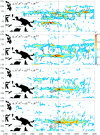Surface Current in "Hotspot" Serves as a New and Effective Precursor for El Niño Prediction
- PMID: 28279021
- PMCID: PMC5427969
- DOI: 10.1038/s41598-017-00244-2
Surface Current in "Hotspot" Serves as a New and Effective Precursor for El Niño Prediction
Abstract
The El Niño and Southern Oscillation (ENSO) is the most prominent sources of inter-annual climate variability. Related to the seasonal phase-locking, ENSO's prediction across the low-persistence barrier in the boreal spring remains a challenge. Here we identify regions where surface current variability influences the short-lead time predictions of the July Niño 3.4 index by applying a regression analysis. A highly influential region, related to the distribution of wind-stress curl and sea surface temperature, is located near the dateline and the southern edge of the South Equatorial Current. During El Niño years, a westward current anomaly in the identified high-influence region favours the accumulation of warm water in the western Pacific. The opposite occurs during La Niña years. This process is seen to serve as the "goal shot" for ENSO development, which provides an effective precursor for the prediction of the July Niño 3.4 index with a lead time of 2-4 months. The prediction skill based on surface current precursor beats that based on the warm water volume and persistence in the subsequent months after July. In particular, prediction based on surface current precursor shows skill in all years, while predictions based on other precursors show reduced skill after 2002.
Conflict of interest statement
The authors declare that they have no competing interests.
Figures







Similar articles
-
Predicting El Niño Beyond 1-year Lead: Effect of the Western Hemisphere Warm Pool.Sci Rep. 2018 Oct 8;8(1):14957. doi: 10.1038/s41598-018-33191-7. Sci Rep. 2018. PMID: 30297822 Free PMC article.
-
South Pacific influence on the termination of El Niño in 2014.Sci Rep. 2016 Jul 28;6:30341. doi: 10.1038/srep30341. Sci Rep. 2016. PMID: 27464581 Free PMC article.
-
Simple stochastic dynamical models capturing the statistical diversity of El Niño Southern Oscillation.Proc Natl Acad Sci U S A. 2017 Feb 14;114(7):1468-1473. doi: 10.1073/pnas.1620766114. Epub 2017 Jan 30. Proc Natl Acad Sci U S A. 2017. PMID: 28137886 Free PMC article.
-
El Niño physics and El Niño predictability.Ann Rev Mar Sci. 2014;6:79-99. doi: 10.1146/annurev-marine-010213-135026. Ann Rev Mar Sci. 2014. PMID: 24405425 Review.
-
El Niño and health.Lancet. 2003 Nov 1;362(9394):1481-9. doi: 10.1016/S0140-6736(03)14695-8. Lancet. 2003. PMID: 14602445 Review.
References
-
- Barnston AG, et al. Skill of real-time seasonal ENSO model predictions during 2002–11: Is our capability increasing? B. Am. Meteorol. Soc. 2012;93:631–651. doi: 10.1175/BAMS-D-11-00111.1. - DOI
-
- Zhang R-H, Zebiak SE, Kleeman R, Keenlyside N. Retrospective El Niño forecast using an improved intermediate coupled model. Mon. Wea. Rev. 2005;133:2777–2802. doi: 10.1175/MWR3000.1. - DOI
Publication types
LinkOut - more resources
Full Text Sources
Other Literature Sources

